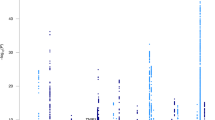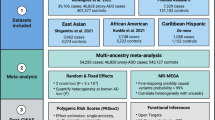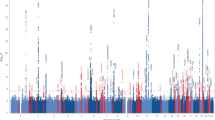Abstract
The past decade has witnessed hundreds of reports declaring or refuting genetic association with putative Alzheimer disease susceptibility genes. This wealth of information has become increasingly difficult to follow, much less interpret. We have created a publicly available, continuously updated database that comprehensively catalogs all genetic association studies in the field of Alzheimer disease (http://www.alzgene.org). We performed systematic meta-analyses for each polymorphism with available genotype data in at least three case-control samples. In addition to identifying the ε4 allele of APOE and related effects, we pinpointed over a dozen potential Alzheimer disease susceptibility genes (ACE, CHRNB2, CST3, ESR1, GAPDHS, IDE, MTHFR, NCSTN, PRNP, PSEN1, TF, TFAM and TNF) with statistically significant allelic summary odds ratios (ranging from 1.11–1.38 for risk alleles and 0.92–0.67 for protective alleles). Our database provides a powerful tool for deciphering the genetics of Alzheimer disease, and it serves as a potential model for tracking the most viable gene candidates in other genetically complex diseases.
This is a preview of subscription content, access via your institution
Access options
Subscribe to this journal
Receive 12 print issues and online access
$209.00 per year
only $17.42 per issue
Buy this article
- Purchase on Springer Link
- Instant access to full article PDF
Prices may be subject to local taxes which are calculated during checkout
Similar content being viewed by others
References
Tanzi, R.E. A genetic dichotomy model for the inheritance of Alzheimer's disease and common age-related disorders. J. Clin. Invest. 104, 1175–1179 (1999).
Saunders, A.M. et al. Association of apolipoprotein E allele epsilon 4 with late-onset familial and sporadic Alzheimer's disease. Neurology 43, 1467–1472 (1993).
Farrer, L.A. et al. Effects of age, sex, and ethnicity on the association between apolipoprotein E genotype and Alzheimer disease. A meta-analysis. APOE and Alzheimer Disease Meta Analysis Consortium. J. Am. Med. Assoc. 278, 1349–1356 (1997).
Bertram, L. & Tanzi, R.E. Alzheimer's disease: one disorder, too many genes? Hum. Mol. Genet. 13, R135–R141 (2004).
Ioannidis, J.P., Ntzani, E.E., Trikalinos, T.A. & Contopoulos-Ioannidis, D.G. Replication validity of genetic association studies. Nat. Genet. 29, 306–309 (2001).
Hirschhorn, J.N., Lohmueller, K., Byrne, E. & Hirschhorn, K. A comprehensive review of genetic association studies. Genet. Med. 4, 45–61 (2002).
Lohmueller, K.E., Pearce, C.L., Pike, M., Lander, E.S. & Hirschhorn, J.N. Meta-analysis of genetic association studies supports a contribution of common variants to susceptibility to common disease. Nat. Genet. 33, 177–182 (2003).
Bracken, M.B. Genomic epidemiology of complex disease: the need for an electronic evidence-based approach to research synthesis. Am. J. Epidemiol. 162, 297–301 (2005).
Colhoun, H.M., McKeigue, P.M. & Davey Smith, G. Problems of reporting genetic associations with complex outcomes. Lancet 361, 865–872 (2003).
Wu, X., Kan, D., Cooper, R.S. & Zhu, X. Identifying genetic variation affecting a complex trait in simulated data: a comparison of meta-analysis with pooled data analysis. BMC Genet. 6 (Suppl.), S97 (2005).
Zurutuza, L. et al. APOE promoter polymorphisms do not confer independent risk for Alzheimer's disease in a French population. Eur. J. Hum. Genet. 8, 713–716 (2000).
Lehmann, D.J. et al. Large meta-analysis establishes the ACE insertion-deletion polymorphism as a marker of Alzheimer's disease. Am. J. Epidemiol. 162, 305–317 (2005).
Del Bo, R. et al. Is M129V of PRNP gene associated with Alzheimer's disease? A case-control study and a meta-analysis. Neurobiol. Aging 27, 770e1–770e5 (2006).
Yasuda, M. et al. Case-control study of presenilin-1 intronic polymorphism in sporadic early and late onset alzheimer's disease. J. Neurol. Neurosurg. Psychiatry 66, 722–726 (1999).
Trikalinos, T.A., Salanti, G., Khoury, M.J. & Ioannidis, J.P. Impact of violations and deviations in Hardy-Weinberg equilibrium on postulated gene-disease associations. Am. J. Epidemiol. 163, 300–309 (2006).
Weedon, M.N. et al. Meta-analysis and a large association study confirm a role for calpain-10 variation in type 2 diabetes susceptibility. Am. J. Hum. Genet. 73, 1208–1212 (2003).
Rockhill, B., Newman, B. & Weinberg, C. Use and misuse of population attributable fractions. Am. J. Public Health 88, 15–19 (1998).
Beffert, U., Arguin, C. & Poirier, J. The polymorphism in exon 3 of the low density lipoprotein receptor-related protein gene is weakly associated with Alzheimer's disease. Neurosci. Lett. 259, 29–32 (1999).
Lehmann, D.J., Williams, J., McBroom, J. & Smith, A.D. Using meta-analysis to explain the diversity of results in genetic studies of late-onset alzheimer's disease and to identify high-risk subgroups. Neuroscience 108, 541–554 (2001).
Rainero, I. et al. Association between the interleukin-1alpha gene and Alzheimer's disease: a meta-analysis. Neurobiol. Aging 25, 1293–1298 (2004).
Peters, J.L., Sutton, A.J., Jones, D.R., Abrams, K.R. & Rushton, L. Comparison of two methods to detect publication bias in meta-analysis. J. Am. Med. Assoc. 295, 676–680 (2006).
Ioannidis, J.P., Ntzani, E.E. & Trikalinos, T.A. 'Racial' differences in genetic effects for complex diseases. Nat. Genet. 36, 1312–1318 (2004).
Munafo, M.R. & Flint, J. Meta-analysis of genetic association studies. Trends Genet. 20, 439–444 (2004).
Thakkinstian, A., McElduff, P., D'Este, C., Duffy, D. & Attia, J. A method for meta-analysis of molecular association studies. Stat. Med. 24, 1291–1306 (2005).
Ioannidis, J.P. et al. A road map for efficient and reliable human genome epidemiology. Nat. Genet. 38, 3–5 (2006).
DerSimonian, R. & Laird, N. Meta-analysis in clinical trials. Control. Clin. Trials 7, 177–188 (1986).
Egger, M., Davey Smith, G., Schneider, M. & Minder, C. Bias in meta-analysis detected by a simple, graphical test. Br. Med. J. 315, 629–634 (1997).
Lange, C., DeMeo, D., Silverman, E.K., Weiss, S.T. & Laird, N.M. PBAT: tools for family-based association studies. Am. J. Hum. Genet. 74, 367–369 (2004).
Levin, M.L. The occurrence of lung cancer in man. Acta Unio Int. Contra Cancrum 9, 531–541 (1953).
Yang, Q., Khoury, M.J., Friedman, J.M. & Flanders, W.D. On the use of population attributable fraction to determine sample size for case-control studies of gene-environment interaction. Epidemiology 14, 161–167 (2003).
Acknowledgements
We are grateful to the Alzheimer Research Forum for hosting AlzGene on their website. In particular, we would like to thank J. Kinoshita, C. Knep and P. Noyes for the online adaptation of AlzGene and many helpful discussions. We would also like to thank the members of the Scientific Advisory Board for their comments and suggestions before and during the development of the database (http://www.alzforum.org/res/com/gen/alzgene/credits.asp), C. Lange for helpful discussions regarding the power calculations and B. Hooli for help with computer programing. Funding for this study was provided by an anonymous donor.
Author information
Authors and Affiliations
Contributions
This study was designed by L.B. (principal investigator), M.B.M., D.B. and R.E.T. Literature searches, data entry and online curation of data were performed by K.M. and L.B. Analysis scripts were developed and written by M.B.M., and analyses were performed by M.B.M. and L.B. The manuscript was written by L.B., with contributions from M.B.M., D.B. and R.E.T.
Corresponding author
Ethics declarations
Competing interests
The authors declare no competing financial interests.
Supplementary information
Supplementary Fig. 1
Overview of literature searches and flow chart for studies in “data freeze” used for all analyses presented in this study. (PDF 68 kb)
Supplementary Fig. 2
Forest plots of random effects meta-analyses using allelic contrasts for polymorphisms showing significant summary ORs (“positive” genes; current on 12/1/05). (PDF 329 kb)
Supplementary Fig. 3
Begg modified funnel plots of random effects meta-analyses using allelic contrasts for polymorphisms showing significant summary ORs (“positive” genes; current on 12/1/05). (PDF 145 kb)
Supplementary Table 1
Number of AD genetic association studies identified in AlzGene vs. two other publicly available databases for ten randomly selected genes (current on March 21st 2006). (PDF 30 kb)
Supplementary Table 2
Overview of all 130 polymorphisms with genotype data available in at least three independent case-control samples in AlzGene on 12/1/05 (referred to as “data freeze” in the paper). (PDF 179 kb)
Supplementary Table 3
Random effects meta-analyses and HWE sensitivity analyses comparing allele vs. genotype contrasts for polymorphisms showing significant summary ORs in the allelic analyses (“positive” results, displayed in Table 2; current on 12/1/05). (PDF 207 kb)
Supplementary Table 4
Population attributable fractions (PAF) of polymorphisms showing significant ORs in allelic contrasts (displayed in Table 2 and Supplementary Table 3). (PDF 38 kb)
Supplementary Table 5
Stepwise correction of between-study heterogeneity for datasets not homogeneous in random effects meta-analyses using allelic contrasts on studies of all ethnicities (current on 12/ 1/ 05). (PDF 74 kb)
Rights and permissions
About this article
Cite this article
Bertram, L., McQueen, M., Mullin, K. et al. Systematic meta-analyses of Alzheimer disease genetic association studies: the AlzGene database. Nat Genet 39, 17–23 (2007). https://doi.org/10.1038/ng1934
Issue Date:
DOI: https://doi.org/10.1038/ng1934
This article is cited by
-
Florbetapir PET-assessed demyelination is associated with faster tau accumulation in an APOE ε4-dependent manner
European Journal of Nuclear Medicine and Molecular Imaging (2024)
-
Cognitive Dysfunction and Exercise: From Epigenetic to Genetic Molecular Mechanisms
Molecular Neurobiology (2024)
-
Prioritizing genes associated with brain disorders by leveraging enhancer-promoter interactions in diverse neural cells and tissues
Genome Medicine (2023)
-
A plasma protein signature associated with cognitive function in men without severe cognitive impairment
Alzheimer's Research & Therapy (2023)
-
Association between APOE-ε4 allele and cognitive function is mediated by Alzheimer’s disease pathology: a population-based autopsy study in an admixed sample
Acta Neuropathologica Communications (2023)



